|
This was the content of this page before we started thinking that
the Coast tiles would only come into play when the tile
map aproaches the edge of the table
Building a Coast Line around a Center Scoreboard
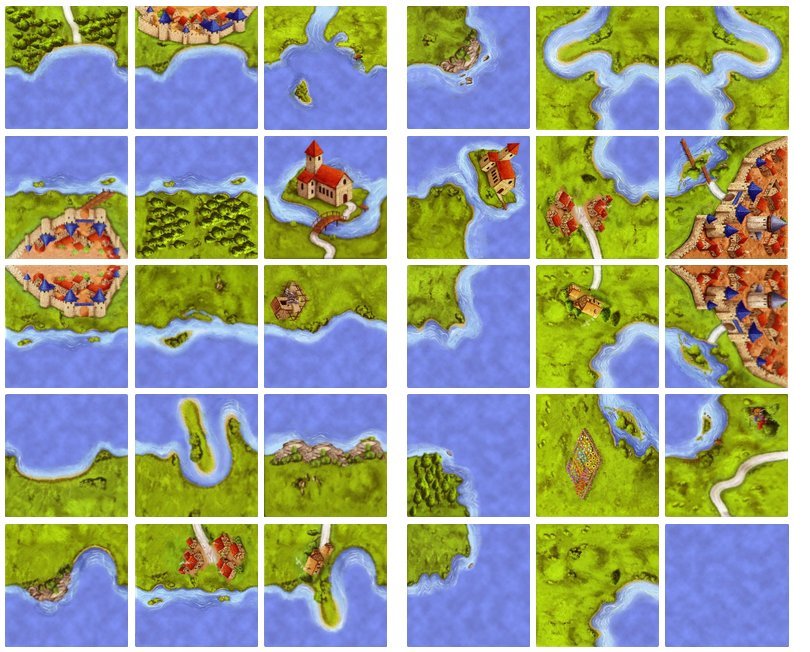
Looking at the standard 30 Coast tiles, there are 15 straight coast tiles
in the first 3 columns, one of which is also a River terminator, and there
are 5 tiles that seem to create the outer edge of a coast line that
could surround the Scoreboard.
There are also 9 tiles that seem to create the inner edge of a
coast line which would basically create a lake within the tile map.
Two
of these tiles are also river terminators that would be helpful when
the river does not terminate pointing away from the scoreboard.
Since we will be playing with a Center Scoreboard, we are not trying
to create a body of water inside of our final tile map. We are
trying to create our final map that will be surrounded by a Coast line
that will basically prevent us from running off the edge of the
table!
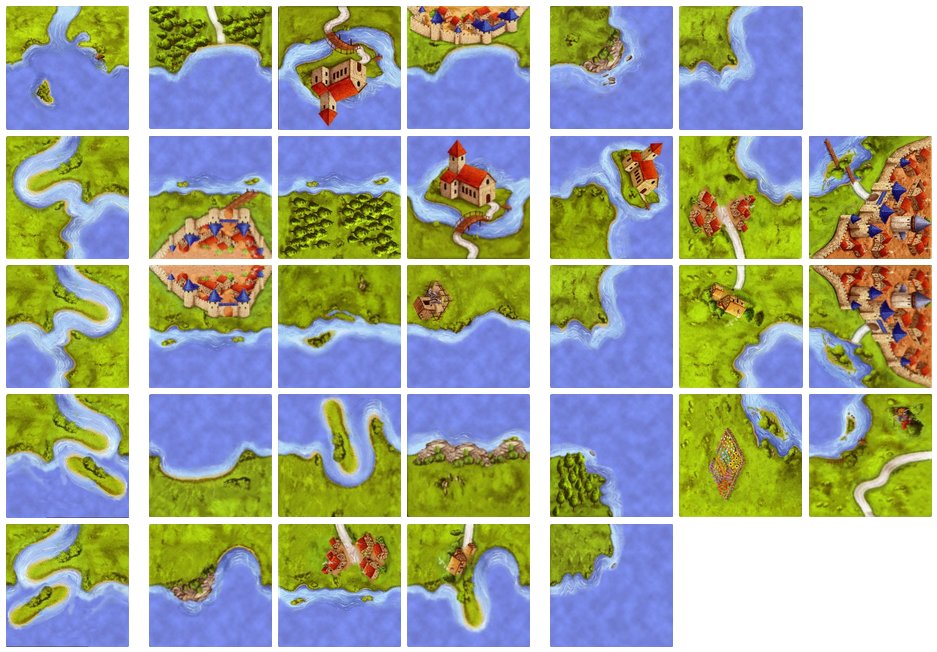
The easiest way to overcome most of this problem would be to eliminate
4 of the inner edge standard tiles. This would leave us with only
3 River Coast tiles. Another way would be to make a couple of
minor modifications to the original Coast tiles.
Do not print the standard  and and
 tiles, replace them with tiles, replace them with
 
 and an extra copy of and an extra copy of
 . .
Plan A: We play with standard 24 River tiles including the following
terminators:
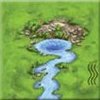 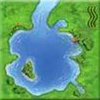
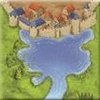 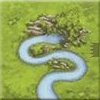
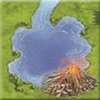 Plus the fork, Plus the fork,
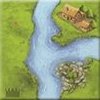
We can keep all 5 of the Coastal River tiles face up on the table
 
 

And each player, as they draw a standard river terminator, can decide to
play a Coastal terminator in its place.
When all of the rivers are complete, we enter the Coastal Phase with 15
straight Coastal tiles, 6 Inward turning Coastal tiles, and 6 Outward
turning Coastal tiles.
Having an even number of Inward and Outward turning Coastal tiles should
keep the coastlines fairly straight as they surround the Scoreboard at
a relative distance.
| 1 | 9 | No Tiles |
|---|
| 2 | 8 | Bump |
|---|
| 3 | 7 | Coast |
|---|
| 4 | 6 | Trigger |
|---|
| 5 | 5 |
|---|
| 6 | 4 |
|---|
| 7 | 3 |
|---|
| 8 | 2 |
|---|
| 9 | 1 |
|---|
| 10 | Score
Board |
|---|
| 11 |
|---|
| 12 |
|---|
| 13 |
|---|
| 14 | 1 |
|---|
| 15 | 2 |
|---|
| 16 | 3 |
|---|
| 17 | 4 |
|---|
| 18 | 5 |
|---|
| 19 | 6 | Trigger |
|---|
| 20 | 7 | Coast |
|---|
| 21 | 8 | Bump |
|---|
| 22 | 9 | No Tiles |
|---|
Table Edge / Coast Line / around Center Scoreboard
The basic concept is that we are going to play with one of our standard
Center Scoreboards, and, we are only going to use the Coast
tiles to insure that our tile map does not run over the edge of the table
we are playing on.
The table that we usually play Carcassonne on is 39.5 inches wide.
Each Carcassonne Tile is almost exactly 1 ¾ inches square which would allow for almost 22 ½ tiles, take away the 4 tiles that make up the Center Scoreboard, that only leaves room for room for 9 ¼ tiles on each side of the scoreboard.
SO, if we create a 1 ¼ No Tile Zone, and a 1 tile Coastal Bump Zone to allow the random placement of an "inner edge" coastal tile immediately followed by an "outer edge" coastal tile, then, a Coast tile has to be laid on the map on the 7th row from the Center Scoreboard immediately after any tile is placed on the 6th row from the Center Scoreboard!
This leads to a lot of questions:
- Depending on the tile that was places on the 6th row, what tiles are allowed on the 7th row?
- If the player who places the 6th row tile is also the player who then places the 7th row tile, does that player get to choose any tile they want for that tile?
- If so, can they choose one of the Monetary tiles and place a meeple on it?
So, now it comes down to some other questions:
- Should there be just one single stack of random Coast Tiles?
- Should there be a separate stack of no-value Coastal Tiles?
- After all of the River tiles have been played, should we combine all
of the Coastal Tiles in a single stack and allow each player to choose
if their next tile is drawn from a random standard stack, or from the
random coastal stack?
During the River phase of our games, these are the types of Coastal
Tile situations that we can expect.
| River |
| Road |
| City |
| Field |
| Monastery |
| River 2 |
| River 3 |
| Row 6 |
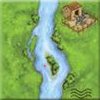 |
| 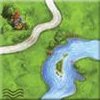 |
| 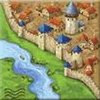 |
|  |
Do We |
 |
|  |
|  |
| Row 7 |
 |
|  |
|  |
|  |
Allow |
 |
|  |
|  |
When the River 2 or River 3 situation occurs, that is when the next
tile has to be one of the Outer Edge Coastal Tiles that will be
placed in Row 8. Moving forward, after the River Phase has been
completed, the Coastlines can be extended with randomly drawn tiles
from the remaining Coastal Tile stack. BUT, however, you can never
place another Inner Edge Coastal Tile within the 8th row.
This leaves us with a lot of questions: do we start the River Phase with
all of the Coastal tiles divided into 4 stacks?
So, basically, we are going to start the game with all of the standard River Tiles, and 22 Coast Tiles divided into 5 stacks; 4 Road / Coast tiles, 3 City / Coast tiles, 7 Field / Coast tiles, 3 River / Coast tiles, and 5 Inner Edge / Coast tiles just in case we are forced to terminate one or more of the Rivers with an Outer Edge River Tile.
The question still remains: what do we do with all of the unused Coast Tiles when all of the River Tiles have been played? Do we combine all of the remaining unused tiles (except for the unused River Termination tiles) into a single stack? Then during the standard tile placement phase of the game, can any player merely draw a tile from the combined Coastal Stack? Also, at this point, do we also include the remaining 7 Inner Edge Coast tiles?
One thing we need to talk about is the actual spacing. After you place a tile on Row 6 from the Scoreboard, the outer edge of that tile will be only 5¾ inches from the edge of the table. Then when you add the Coastal Tile to Row 7, that tile will be only 4 inches from the edge of the table. And if the situation occurs where the Coast takes a turn toward the edge of the table and immediately turns back onto a Coast Line, the new Coast Line will be only 2¼ inches from the edge of the table. If we decide to start our Coast Lines when Row 7 gets a standard tile, the Coast line could get within only ½ of an inch from the edge of the table.
Our New House Rules for a Center Scoreboard Coast Line
We are going to use 29 of the 30 original Coast tiles, plus 3 additional
tiles that we created. We are going to eliminate the original solid blue
tile, we split the standard River Coast tile into 2 additional corner
tiles, and we modified the original Road Monastery tile to create an
additional Field Monestary tile.
The only purpose for this expansion is to keep our tile maps from
running over the edge of the table.
At the start of every game, randomly shuffle all 32 of the Coast tile
and divide them into the following 5 face up stacks:
| Row 8 |
 |
|  |
|  |
|  |
|  |
|  |
|  |
| |
| River |
 |
|  |
|  |
| |
| Road |
 |
|  |
|  |
|  |
|  |
|  |
|  |
| |
| City |
 |
|  |
|  |
|  |
|  |
| |
| Field |
 |
|  |
|  |
|  |
|  |
|  |
|  |
|  |
|  |
|  |
Play the game as usual with the River, then the standard tiles.
At any time during the game, whenever a player places any tile that
is about 6 inches (3 tiles) away from the edge of the table, that
player gets a "Coastal Second Turn".
- Based on the edge of the new tile that is facing the edge of
the table,
- Draw the face up tile from the top of that Coastal Stack and
place it on the board next to your original new tile.
- Yes, you are allowed to claim features on the Coastal
tile.
- Monasteries and Gardens are scored as usual, but the solid
water tiles that would normally be part of the 8 surrounding
tiles are not required to complete the feature, so you just
score less points when the feature is "complete".
- If the new Coastal Tile also creates a coast line that is
pointing away from the center of the table again, take a
"Coastal Third Turn".
- Draw the face up tile from the top of the Row 8 stack and add
it to the edge of the first Coastal Tile so that the new new
coastline is parallel to the edge of the table.
Let's take a closer look at this Row 8 bump situation
When an Inner Edge River 2 or
River 3 situation occurs, that is when the next tile has to be one of
the Outer Edge Coastal Tiles
that will be
placed in Row 8 to turn the Coastline back to parallel to the edge of
the table. Moving forward, after the River Phase has been
completed, the Coastlines can be extended with randomly drawn tiles
from the remaining Coastal Tile stacks.
What if a city tile is then placed next to the River 2 or 3 tile in Row
7, and the City Coast tile also requires a second "bump" tile to be
placed in Row 9? Do we allow the tile map to expand to within less than
an inch from the end of the table? Or do we set up a house rule that
would allow us to choose a different City Coast tile when there is a
Row 9 situation?
We are going to have to come up with some house rules, similiar to the
No U-turn rules for the
Rivers, for how we handle the situation after a Row 8 Coastline has
been created. Basically creating our own
No Row 9 rules!
Basically, this extra 32 tile fan-expansion should not add any extra
time to our games. The player has no choice on what tile to draw for
a second or third coastal turn, and for the most part, it can only be
placed on the board one way.
|